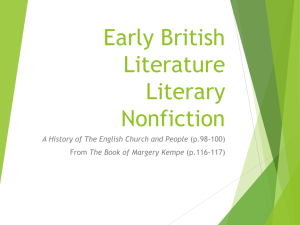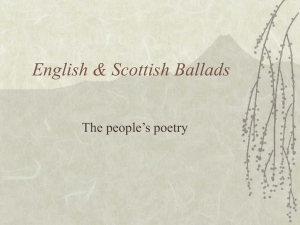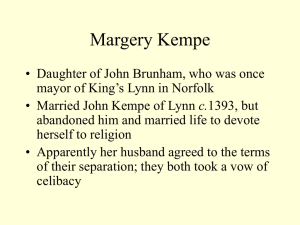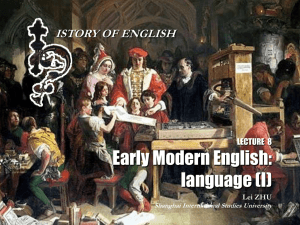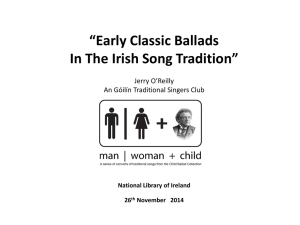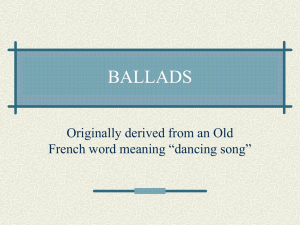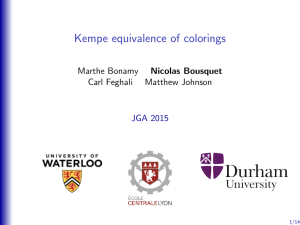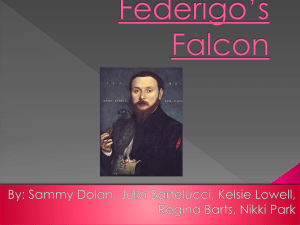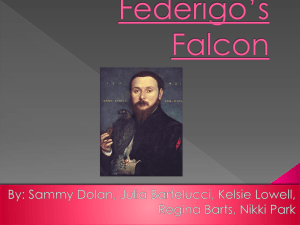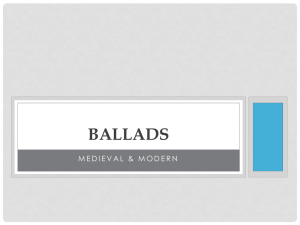NOTES - Medieval Literature - Part 1
advertisement
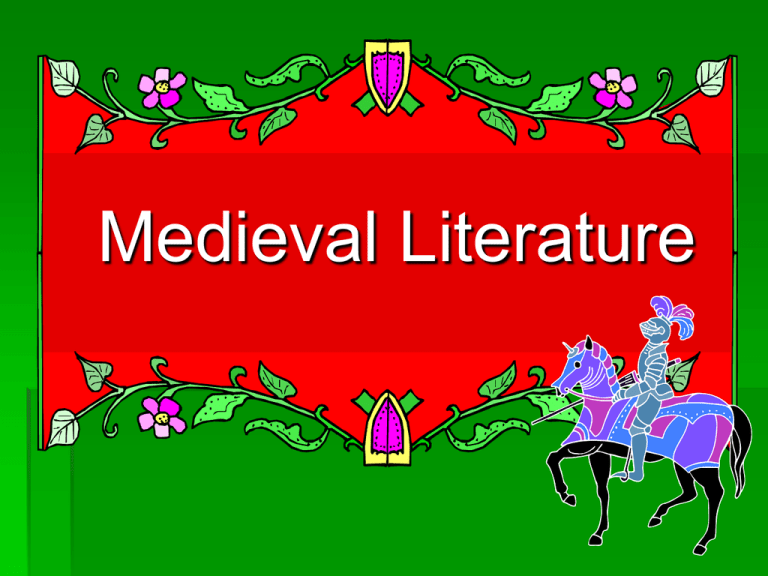
Medieval Literature Federigo’s Falcon Federigo’s Falcon Author: Giovanni Boccaccio (1314-1375) Genre: Short Story; Frame Story Source: Decameron – A collection of 100 stories using the literary device of framing; Chaucer imitated Boccaccio’s frame structure in The Canterbury Tales. Importance: Reveals medieval attitudes about love, marriage, chivalry, and separation between classes. Background: • Begins with a description of the Bubonic Plague (specifically the epidemic that hit Florence, Italy in 1348). • Leads into an introduction: 7 young women and 3 young men flee plague-ridden Florence to a villa in the countryside for two weeks. • To pass the time, each character tells one story for each night at the villa. Fourteen days pass but two days each week are set aside: one for chores and one holy day. • 100 stories are told by the end of the ten days. (Decameron = “10 days”) Background (cont’d): • Each character is “King” or “Queen” for one of the ten days in turn, to choose the theme of the stories for the day. • Each day includes a short introduction and conclusion describing the day’s activities. (Framing) • In the whole of the collection, Boccaccio imitates a variety of previous material and forms. His stories mock the greed of the clergy, reveal tensions between classes, and portray the perils and adventures of travel. • Topics: power of fortune; the power of human will; love tales that end tragically; love tales that end happily; tricks that people play on one another; stories of virtue. Summary: Monna Giovanna’s son becomes seriously ill and asks his mother for one thing only to make him happy—Federigo’s Falcon. Monna goes to Federigo’s farm to ask for it. Because Federigo has nothing to serve so great a woman (with whom he has been in love), he roasts his beloved falcon & serves it to her. He learns the true purpose of her visit too late, & soon after, the child dies. After a period of mourning, Monna is urged to remarry & finally gives her heart to Federigo. The Paston Letters Paston Letters Author(s): The Paston Family Genre: Letters—First person; personal; include dates (often reference to a season or a holy day), salutations, signature. Source: 1,000 documents and letters of the Paston Family, an English landowning family. Importance: Reveal various details regarding business affairs, property matters, legal disputes, the plague’s effect on people, the importance of arranged marriages. Background: The Paston family rose from the peasantry to the aristocracy within just two generations. Their letters are the first record of private correspondence to survive in Britain. They offer a unique glimpse into the concerns and fears of a very upwardly mobile family at a time of huge social upheaval. They show first-hand testimony of the social benefits the plague brought to the peasantry, the chaotic effects of the Wars of the Roses on the general populace and the individual impact that the Black Death could have on a family. Summary Letter I – Margaret Paston explains to her husband, John, that she has fled the family estate at Gresham after learning that it may be attacked by Lord Moleyns. Letters 2 & 3 – Margaret describes events at another Paston estate, Hellesdon, where the Duke of Suffolk has attacked. Some of the servants and supporters are captured. The Duke of Norwich orders all who support John I to be arrested. Margaret writes of the expenses and troubles each day brings and urges John to settle his business in London and return as soon as possible. Letter 4 – Written from Richard Calle (the Paston’s bailiff) to Margery Paston (John and Margaret’s daughter). Richard and Margery were secretly engaged, despite opposition from family. Richard expresses his love to Margery and his concern for the trouble she faced because of him. This letter is the only piece of correspondence between them to survive. Summary (cont’d): Letter 5 – Margaret Paston writes to her oldest son, John II, regarding her disapproval (and disownership!) of her daughter Margery due to the relationship with Richard Calle. Letter 6 – A year later, Margaret again writes to son John II, this time regarding the need for John II to take financial responsibility. Letter 7 – John II writes to his mother, Margaret, to ease her mind regarding John III, who has been injured by an arrow but is otherwise in good health. He also informs her of the death of a family friend. Letter 8 – John II writes to John III seeking more information about the plague and who has been affected by it. He advises the family to send the ill to the country. Ballads Author(s): English Commoners; Unknown Genre: Ballads (Folk Ballads) are narrative poems originally intended to be sung; usually focus on a single incident; begin abruptly; use dialogue (& dialect), repetition, and quatrains (four-line stanzas). Rhyme scheme is often abcb or aabb. Source: Oral tradition; Minstrelsy of the Scottish Border by Sir Walter Scott Importance: Offer a glimpse of the lives of “ordinary people.” They are the “true songs of the people.” Subjects include: tragic love, domestic conflict, crime, war, and shipwreck. Background: • No one knows when the first folk ballads appeared in Britain; probably during the 12th century. • Unwritten; passed along orally for many centuries. • Most of the earliest ballads we know of probably date from the 15th century. At that time, no one paid much attention to them as literature. • 1765, Bishop Thomas Percy published Reliques of Ancient English Poetry. This helped ballads come to be recognized as a part of Britain's literary heritage. • Sir Walter Scott, author of Ivanhoe, was influenced by Percy's Reliques. Scott often traveled to the ScottishEnglish border region to collect material on the subject. His Minstrelsy of the Scottish Border, published in 1803, is a pioneer work of scholarship on the background and variations of Scottish ballads. Background (cont’d): • “Barbara Allan,” “Sir Patrick Spens,” and “Get Up and Bar the Door,” originated in this wild, rugged border country between England and Scotland. Their language is the Scots dialect of English. • As they were passed along from person to person, place to place, and generation to generation, the ballads often acquired new words and new verses. • No such thing as a “standard version” of a folk ballad, because every balladeer feels free to make alterations. Literally hundreds of versions of "Barbara Allan" have appeared in print. Folk ballads, with their familiar melodies, are truly songs of the people. • Later writers, including Sir Walter Scott, produced literary ballads in imitation of the traditional ones. Few literary ballads have had the power of the old folk ballads to capture and hold the imagination Summary of “Barbara Allan”: This ballad focuses on the relationship between a woman named Barbara Allan and Sir John Graeme. Sir John is in love with Barbara Allan and when he faces his death bed, he sends a young man to go get her. She is slow to visit him, and when she finally does, all she focuses upon is an insult he once made about her. He dies with his love for her unfulfilled. She leaves to the sound of his death toll. Famous line: “Since my love died for me today, I’ll die for him tomorrow.” NOTE: This ballad has influenced many musicians of modern culture, including Art Garfunkel, Joan Baez, The Everly Brothers, Johnny Cash, Pete Seger, Bob Dylan, and Emmylou Harris, to name a few. Joan Baez: http://www.youtube.com/watch?v=8woUkSu7FBs&feature=related Emmylou Harris: http://www.youtube.com/watch?v=rKRh00_YBkY&feature=related Summary of “Sir Patrick Spens”: This tragic ballad describes the loss at sea of a Scottish ship, its commander, and the crew. The king needs a good sailor and is told by an elderly knight, “Sir Patrick Spens is the best sailor / That sails upon the sea.” When Sir Patrick receives word, he is upset because it is not a good season for setting sail (most likely winter or early spring—full of storms). He submits to the king’s will, however, and he and his crew all die at sea. Summary of “Get Up and Bar the Door”: This humorous ballad tells the story of a strong-willed husband and wife who are both so stubbornly locked in argument that they ignore common sense as well as danger. On a windy night, the husband tells his wife to “Gae out and bar the door.” She replies by saying she’s too busy with chores and that “It’s no be barrd for me.” They made a deal that the first person to speak had to go shut the door. At midnight, two burglars arrive. They eat the couple’s food and then threaten to shave the husband’s beard off while the other kisses the wife. When they find no water to use to shave the man’s beard he finally speaks up in protest. The wife then happily responds by pointing out that he’s said the first word and has to get up and go bar the door! The Book of Margery Kempe Author: Margery Kempe (1373?-1439?) Genre: Autobiography—personal account of the writer’s life; reveals writer’s attitudes, motivations, values, and society; usually written in first person (though Kempe’s is not most likely because of her view of herself and her humility). Source: The Book of Margery Kempe Importance: Earliest known autobiography in English. Portrays the author’s life as a religious visionary and recluse; offers another “option” for medieval women. Background: • Kempe was the daughter of a respected merchant and public official; grew up in a wealthy family but was never given a chance to be educated. • Married merchant John Kempe in 1393, with whom she had fourteen children. • In her twenties, began to have visions in which she talked to Jesus, Mary, and the Saints. In one vision, Jesus told her to go deeper in her religious practices. • Dedicated her life by the call of Jesus in an unusual state by weeping, screaming and praying for Christians during religious services. She became so involved that she detached her daily life from her husband and children and set out on a long journey ending up in Jerusalem. • When her pilgrimage comes to an end she dictates her spiritual autobiography to scribes. • The Book discusses her marriage, religious conversion, and many pilgrimages. Throughout the work, Kemp refers to herself as “this creature,” a standard way of saying "this person, a being created by God.“ Kempe’s work was dictated to scribes and made into an illuminated manuscript—a manuscript in which the text is supplemented by additional borders, illustration, and other decoration. Well-known Quote: “When people think he is far away from them, he is very near through his grace.” Summary: Kempe recounts the troubled period before and after the birth of her first child. After her child was born, Kempe, thinking that she was about to die, wanted to confess something that had long troubled her. As she begins to confess, her confessor passed judgment on her, so she would say no more. Soon after, Kempe “went out of her mind,” having visions of devils and performing wicked and selfdestructive acts. After many months, she said Christ appeared to her, assuring her that he had never forsaken her. Afterward, Kempe grew calm and resumed her normal daily life. Sources: DiGrado, Elena (2005) and Juliana Kane (1998).. “Margery Kempe.” Women’s History. King’s College History Dept. <http://departments.kings.edu/womens_history/margerykempe.html`> Ibeji, Dr. Mike. “Paston Family Letters.” (October 15, 2010). British History in Depth. BBC. <http://www.bbc.co.uk/history/british/middle_ages/pastonletters_01.shtml> Kempe, Margery. The Book of Margery Kempe. Language of Literature: British Literature, The. Evansont, Illinois: McDougal Little, 2002. “Luminarium: Anthology of English Literature.” From: The Norton Anthology of English Literature, 6th Ed. Vol. 1. , New York: W. W. Norton & Company, 1993. <http://www.luminarium.org/medlit/kempe1.htm> “Medieval Folk Ballads.” BritlitBallads. <http://pdkphs.tripod.com/britlit/ballads.html>

